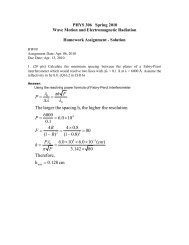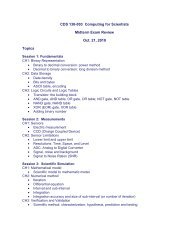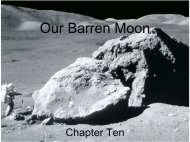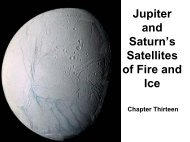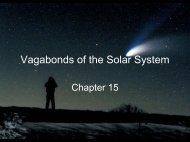Our Barren Moon
Our Barren Moon (pdf)
Our Barren Moon (pdf)
Create successful ePaper yourself
Turn your PDF publications into a flip-book with our unique Google optimized e-Paper software.
<strong>Our</strong> <strong>Barren</strong> <strong>Moon</strong><br />
Chapter Ten
ASTR 111 – 003 Fall 2007<br />
Lecture 09 Oct. 29, 2007<br />
Introduction To Modern Astronomy I:<br />
Solar System<br />
Introducing Astronomy<br />
(chap. 1-6)<br />
Planets and <strong>Moon</strong>s<br />
(chap. 7-15)<br />
Chap. 16:<br />
Chap. 28:<br />
Ch7: Comparative Planetology I<br />
Ch8: Comparative Planetology II<br />
Ch9: The Living Earth<br />
Ch10: <strong>Our</strong> <strong>Barren</strong> <strong>Moon</strong><br />
Ch11: Earthlike Planets<br />
Ch12: Jupiter and Saturn<br />
Ch13: Satellites of Jupiter & Saturn<br />
Ch14: Uranus, Neptune and Beyond<br />
Ch15: Vagabonds of Solar System
Earth-<strong>Moon</strong> System<br />
• Diameter: 3476 km, or 27% of Earth<br />
• Mass: 1.23% of Earth Mass<br />
• Density: 3344 kg/m 3<br />
• Average distance: 384,400 km, or ~ 30 Earth diameter<br />
• Round-trip of light: 2.6 sec<br />
• Spacecraft at 10 km/s: 10 hours<br />
• Car at 60 mi/hr: 167 days<br />
• Elliptical orbit: eccentricity 0.05<br />
• Inclination of orbit to ecliptic: 5°<br />
• Inclination of lunar equator to orbit: 7°
• Liberation:<br />
Earth-<strong>Moon</strong> System<br />
–The synchronous rotation of <strong>Moon</strong> is not perfect.<br />
FLASH<br />
1003001.mov<br />
– It wobbles slightly, rocking back and forth around its<br />
north-south axis and nodding up and down in a northsouth<br />
direction.<br />
– The liberation permits us to view 59% of the <strong>Moon</strong>’s<br />
surface<br />
– The liberation is caused by the <strong>Moon</strong>’s non-circular orbit<br />
and the inclination angle<br />
• Earth and <strong>Moon</strong> both orbit around a point between their<br />
centers called the center of mass<br />
– The center of mass is very close to the Earth’s center
• None<br />
<strong>Moon</strong>’s Atmosphere<br />
– The gravity is too weak to retain any atmosphere
<strong>Moon</strong>’s Surface<br />
• Extremely old surface<br />
– Covered with numerous<br />
craters, e.g, 30,000 craters<br />
larger than 1 km/s<br />
– These are impact craters.<br />
– no plate tectonic activity on the<br />
<strong>Moon</strong><br />
• <strong>Moon</strong> is too small to retain<br />
internal heat<br />
• The entire crust is a single<br />
plate<br />
FLASH<br />
10cc1.swf
<strong>Moon</strong>’s Surface<br />
1. Maria (mean “sea”)<br />
– the dark area<br />
– low-lying plains<br />
– 15% of surface<br />
2. Highlands<br />
– the light-colored area<br />
– highlands on the<br />
<strong>Moon</strong><br />
– 85% of surface
• Maria<br />
<strong>Moon</strong>’s Surface<br />
– Maria have relatively less denser<br />
craters<br />
– Maria (~ 4.0 billion years) are<br />
relatively younger than<br />
highlands (~ 4.5 billion years).<br />
– Mare basin was caused by<br />
impacts of very large meteoroids<br />
or asteroids at a later time (~ 4.0<br />
billion years ago)<br />
– Lunar crust is cracked by the<br />
large impact, causing lava<br />
flooding the basin<br />
– dark color is due to solidified<br />
lava
Human Exploration<br />
• From 1969 to 1972, 12 astronauts walked on the <strong>Moon</strong>,<br />
through 6 successful manned landings<br />
• July 21, 1969, 2:56 UTC, Armstrong put his left foot on the<br />
surface, and spoke<br />
– That's one small step for (a) man, one giant leap for<br />
mankind.
Human Exploration<br />
• About 400 kg of lunar materials have been brought back<br />
by Apollo astronauts<br />
• Seismic equipment have been put on the <strong>Moon</strong> to detect<br />
moonquakes and deduce the structure of the moon’s<br />
interior<br />
• Mirrors have been put on the <strong>Moon</strong> to measure the<br />
accurate Earth-<strong>Moon</strong> distance using Laser light: moon<br />
spiraling away at 3.8 cm/year
Human Exploration<br />
• The second race to the <strong>Moon</strong><br />
– Aim to set up large and permanent bases<br />
– NASA’s Constellation Project<br />
• Send astronauts back to <strong>Moon</strong> in 2018<br />
• Build a large scale <strong>Moon</strong> base in the next 25 years<br />
– China’s Chang’e project<br />
• Chang’e 1 launched on Oct. 24, 2007<br />
– Japan’s moon project<br />
• Kaguya spacecraft launched on Sep. 14, 2007
Internal Structure<br />
• Like the Earth, the <strong>Moon</strong> has crust, mantle, and core<br />
• Core:<br />
– ~700 km in diameter, relatively small<br />
– iron rich, partially liquid<br />
– not producing global magnetic field<br />
• <strong>Moon</strong>’s solid lithsophere is about 800 km thick<br />
– In contrast, the Earth’s lithosphere is only 50 km thick<br />
– Therefore, <strong>Moon</strong> has no plate tectonics
<strong>Moon</strong>quake<br />
• <strong>Moon</strong>quakes are measured by seismometer set up by<br />
astronauts<br />
• <strong>Moon</strong>quakes are rare in frequency and small in scale<br />
• Originate 800 km below the surface, marking the<br />
boundary between solid lithosphere and plastic<br />
asthenosphere<br />
• The moonquakes are caused by the Earth’s tidal force<br />
– Tidal force deforms the solid body of the <strong>Moon</strong><br />
– The force is greatest when the moon at perigee (most<br />
frequent quakes are observed)<br />
– The force is weakest when the moon at apogee
• Collisional-ejection theory:<br />
– the proto-Earth was struck by a Mars-sized protoplanet<br />
– debris from this collision coalesced to form the <strong>Moon</strong><br />
• This theory explains<br />
Formation of the <strong>Moon</strong><br />
– Low density of <strong>Moon</strong><br />
– Small core of <strong>Moon</strong><br />
– Because the Earth’s iron has sunk to its center due to<br />
chemical differentiation, little iron would have been<br />
ejected from the surface<br />
FLASH<br />
1003002.mov
Formation of the <strong>Moon</strong><br />
• Collisional-ejection theory:
Tidal Forces<br />
• The Earth’s tidal force on the <strong>Moon</strong> produces the<br />
synchronous rotation of the <strong>Moon</strong><br />
• The <strong>Moon</strong>’s tidal force on the Earth slows down the<br />
Earth’s rotation, through the friction between Earth and its<br />
bulged oceans; 0.002 sec per century
Final Notes on Chap. 10<br />
• There are 5 sections in total<br />
• Section 10-4 (on <strong>Moon</strong> rocks) is not covered





